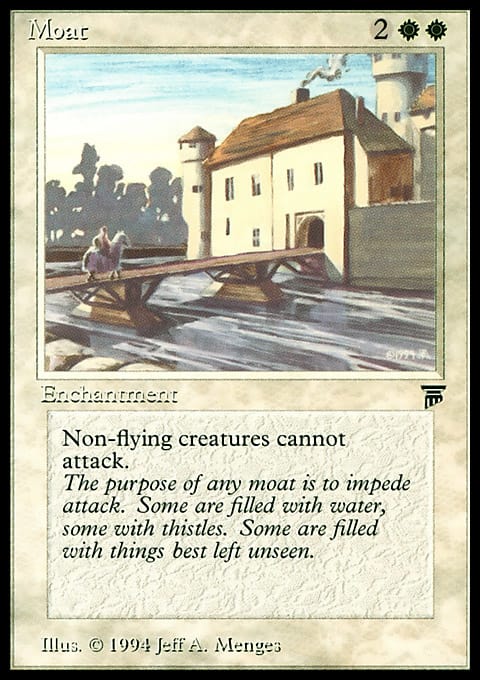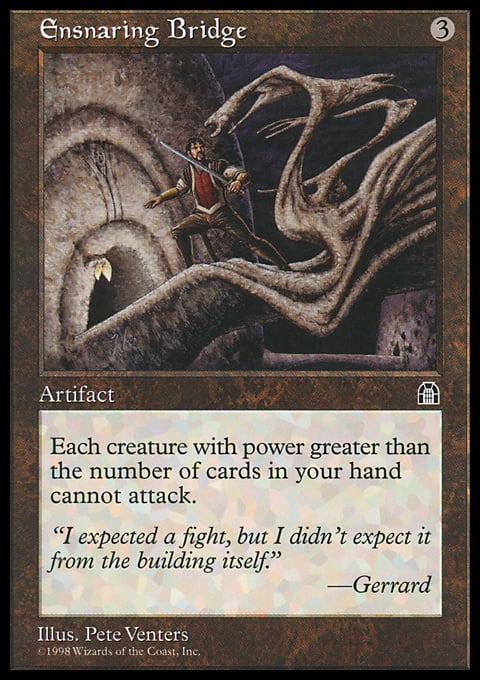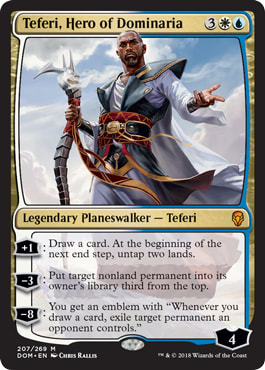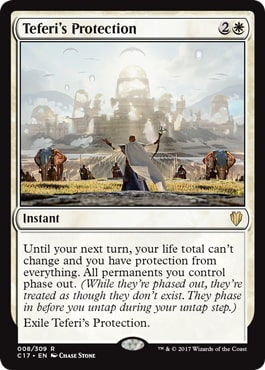Imagine my surprise when at the Las Vegas Gathering I walked past the Oathbreaker booth, not because it was small or hidden in the corner but rather the opposite. Its prime location at the entranceway meant everyone saw it, or should have. Really, how did I miss that banner?

You can see one full table here. There was another, often with two pods of Oathbreaker going at once. The same as in Commander, four is the ideal number for multiplayer. Three is unbalanced. Five means someone ends up forgotten, as happened to one Ral, Storm Conduit, who achieved the perfect storm and comboed everyone into etherized particles. In the following game, another Ral, Storm Conduit player combo killed us again. I was singed. I also learned some valuable lessons about Oathbreaker over the Vegas weekend.
Lesson One: The Power of Pro-Active Strategies
In the new format of Oathbreaker, you have two cards in your command zone, or your locket, as we call it. The first is a Planeswalker, your Oathbreaker. As long as they remain in play you may cast their signature spell. (Commander tax applies in the normal way for each time you recast either card.) Because you control the two spells in your locket, you can design your deck with a powerful and consistent strategy.
This goes infinite faster than lightning, alongside any number of other copying cards in your deck. It's an example of a proactive strategy, one designed to win rather than to prevent your opponents from winning. One game I lost to Ral was when I sat down with my Nahiri, the Harbinger deck. She has a cohesive plan of vengeance all her own, but it's a full turn slower than Ral's. Because most of her deck was designed to interact with creatures or block them as walls, I had little ability to stop his combo.
Having decks packed with aggressive creatures is both a pro-active strategy itself and can counter an opponent's by killing their Oathbreaker. True, they could wait until they have enough mana to cast their Planeswalker and their signature spell in the same turn, but not if you're pressuring their life total. I did just that with Sorin, Imperious Bloodlord.

Now you may think then an aggressive creature strategy is the best one for Oathbreaker. I thought so too, until Jason of the Magikids charity stole my best vampire with Sarkhan Vol then sacrificed the poor child of the night with his signature spell Metamorphosis.
Lesson Two: The Power of Reactive Strategies
Metamo-Who-Dis? | Oathbreaker | Jason Egginton
- Locket (2)
- 1 Sarkhan Vol
- 1 Metamorphosis
- Creatures (25)
- 1 Bazaar Trader
- 1 Birds of Paradise
- 1 Bloodbraid Elf
- 1 Bloodshot Cyclops
- 1 Bloodspore Thrinax
- 1 Conquering Manticore
- 1 Dragon Broodmother
- 1 Elvish Skysweeper
- 1 Emrakul's Evangel
- 1 Enthralling Victor
- 1 Gobbling Ooze
- 1 Hornet Nest
- 1 Hornet Queen
- 1 Humble Defector
- 1 Magmaw
- 1 Mycoloth
- 1 Nest Invader
- 1 Pathbreaker Ibex
- 1 Pilgrim's Eye
- 1 Plaguemaw Beast
- 1 Scorched Rusalka
- 1 Skirsdag Cultist
- 1 Sylvan Ranger
- 1 Temur Sabertooth
- 1 Zealous Conscripts
- Planeswalkers (2)
- 1 Arlinn Kord
- 1 Domri Rade
- Instants (4)
- 1 Ancient Grudge
- 1 Atarka's Command
- 1 Momentous Fall
- 1 Starstorm
- Sorceries (2)
- 1 Primal Command
- 1 Traitorous Instinct
- Artifacts (4)
- 1 Armillary Sphere
- 1 Gruul Signet
- 1 Mage Slayer
- 1 Thought Vessel
- Lands (22)
- 10 Mountain
- 11 Forest
- 1 Gruul Guildgate
This deck impressed me for multiple reasons, and Jason graciously agreed I could post it here. First, it's tricky, and because the cards are strange your opponents may dismiss them. When I first played against it I had no idea a Bazaar Trader could give you permanent control of a creature you've stolen. That's real bizarre. Second, I felt at Jason's mercy every time I played a creature-centric deck against him. The better the creature I played to try to overcome him, the more damage I would take once it was stolen, tapped to slap me in the face, and then sacrificed. The redundancy designed into the deck meant that killing his Oathbreaker would not necessarily mean my strategy was safe. He could Goatnap my loyal servants in any number of ways.
I also loved the signature spell, Metamorphosis. It's one of the many early and evocative Magic card designs that captured my imagination as a child. Likely you have many of your own. Maybe they never fit into a competitive Constructed deck. If one is a sorcery or instant, you can start your deck-building with it as your signature spell. Then you can search for Planeswalkers within its colors and choose the most appropriate one as your Oathbreaker. That's how Jason Egginton designed this deck.
Jason is the founder of the Weirdcards Charitable Club and Magikids, a charity that ships your draft chaff to kids in need of games. Don't fill up trash heaps. Fill up children's imaginations. Ever wondered what to do with your non-recyclable Magic cards? Give them to Jason. You can find him at the Magikids booth at every state-side Magic Fest. He and his orgs are also responsible for popularizing Oathbreaker.
You may wonder if Jason is wise to the best thing you can do in the format by designing a strategy adept at reacting to creatures. Ah, but remember Lesson One. My Nahiri, the Harbinger is also designed to thwart creature strategies, and I was blitzed by Ral's more proactive combo. Similar to how aggro decks tend to beat midrange decks in 1-v-1 but not multiplayer, there's no one correct strategy in Oathbreaker. And that's good news. You can play the deck that speaks to you, and when deciding, pick something that's fun. This is after all a casual format of a card game.
It's hard to have fun in any game if you feel like people constantly gang up on you. That was the case of another Nahiri player. We played a few games, and given the composition of his deck -and the effective politics of his "friend" - he was always perceived as the greatest threat at the table. Because of this, he always died first. He became frustrated. Now, he could've added more interaction to his deck. He could've kept a lower profile with better politics. He could've also selected a deck whose power level matched the table's. Then he wouldn't have stood out as the obvious threat.
Lesson Three: Match Deck Power Levels
Matching against decks of similar strength will result in more interesting games. You could say, "Should I play a competitive, medium, or easy-going deck?" Playing a powerhouse deck at a table full of flavor-first ones will mean the game will end too quickly, either with dominance or an alliance to overcome the power-mad villain, as happened to the opposing Nahiri player.
That's not to say you're wrong to own a single Oathbreaker deck. It's a new format, and it's a bit much to expect people to have multiple options. Still be forward about the power level of your deck. Or if you're new to the format and aren't sure, like many people will be, say so. The other players should cut you some slack, which in some cases may be their first mistake.
A definite mistake would be leaving your Oathbreaker deck at home. Multiple people walked by the booth, wishing they had brought theirs. Again, Magikids will be at every state-side Magic Fest. Don't be consumed with regret.
Lesson Four: Bring Your Oathbreaker Deck
We're all new to Oathbreaker. We're all learning. For instance, did you know these cards are legal in Oathbreaker?
That brings us to lesson number five.
Lesson Five: Play Permanent Interaction
After my opponent played Solitary Confinement I came to the rude realization I only had a single card in my deck that could destroy that permanent type, Generous Gift, and there the white elephant was, sitting in my graveyard like an unwanted reboot of Dumbo. I had no remaining outs and had to concede.
I suggest playing 2-3 cards in your deck that can remove the more difficult permanent types. White has many Oblivion Ring effects, but even other colors have a few answers, such as Chaos Warp, Beast Within, and Reality Shift.
Oathbreaker doesn't have as many powerful artifacts as you find in Commander, thanks to the ban on Sol Ring and the lesser need for ramp. Most often you want to interact with your opponent's life and the loyalty of their Planeswalkers. Players start off at twenty life in Oathbreaker, which can lead to swingy and quick games, but they won't always be over fast. Players may recast their Planeswalker multiple times. You may be forced to attack and kill the card multiple times, and in doing so you may inflict far more than twenty damage total to each player and their 'Walkers.
Lesson Six: Oathbreaker Games Can Be Long
At Vegas we set a new record for the longest Oathbreaker game played, over three hours. Multiple reactive decks stymied each other. I recast my Oathbreaker Kiora and her signature spell more times than I care to admit. The dice in the picture below represent commander tax.

The strength of the sea is not soon stopped by mere creatures or levees. I tend to believe Oathbreaker games are faster than Commander but not that much faster. A better way to distinguish the casual formats is by the cards allowed in the command zone. If you're enchanted by a creature card, design a Commander deck. If what fills you with glee is a Planeswalker, instant, or sorcery, build you an Oathbreaker.
Lesson Seven: Play Oathbreaker to Feature the Cards You Love
Personally, what I love in casual formats is flavor. And I found a banquet of that at the Vegas Gathering. Look at this grudge match between three former Planeswalker allies.

Pitting Planeswalkers against each other has a satisfying comic-book feel to it. The flavor within a deck also delights. Since you need fewer total cards than in Commander you can pick even more thematic ones, and the combination of your Oathbreaker and signature spell can congeal that flavor into something consistently satisfying. The locket below is one I encountered in Vegas. It also brings us to our last two lessons learned.
Lesson Seven: Flavorful Decks Can Still Be Powerful































